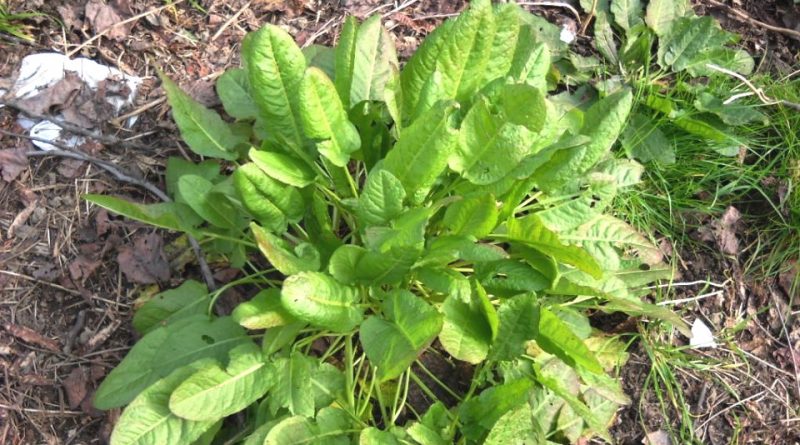Rumex acetosa
Rumex acetosa
Sorrel (Rumex acetosa L.) is a perennial herbaceous species belonging to the Polygonaceae family.
Systematic –
From a systematic point of view, it belongs to the Eukaryota Domain, Kingdom Plantae, Subregion Tracheobionta, Division Magnoliophyta, Class Magnoliopsida, Subclass Caryophyllidae, Superorder Poligonae, Order Poligonales, Family Polygonaceae and therefore to the Genus Rumex and to the species R. acetosa.
The term is synonymous:
– Acetosella vulgaris (W.D.J. Koch) Fourr ..
Etymology –
The term Rumex comes from javelin rumex, spear: due to the pointed shape of the leaves of many species of this genus. Already in Plautus and others with the meaning of romice.
The specific sorrel epithet comes from acētum vinegar: acid like vinegar.
Geographical Distribution and Habitat –
Sorrel is a plant native to an area between Eurasia and the British Isles. This plant was introduced in most of the rest of the northern hemisphere.
In Italy it is present almost everywhere, from the sea to the mountains, in open places and along waterways.
The plant is an indicator of nitrogen-rich soils and is commonly found on acidic and sandy soils in heaths and meadows. It is also often one of the first species to take over disturbed areas, such as abandoned mining sites.
Description –
Rumex acetosa is a perennial herbaceous plant with a straight slender and reddish stem that is branched at the top and can reach a height of 50 cm.
The leaves are of two types: the basal ones form a rosette and are provided with a long petiole, with an astate type shape; those arranged along the stem are sessile and have no stalk.
The flowers are divided into masculine, reddish in color, arranged in bundles on a small slender panicle, and feminine.
Flowering begins in late spring and lasts all summer, normally from June to August.
The fruit is an achene covered with persistent petals that take on a rusty red color.
Cultivation –
Sorrel is an edible spontaneous plant that is also grown for ornamental purposes in rustic gardens and botanical gardens.
In addition, in recent decades the plant has been cultivated as an officinal plant directly at home for various commercial purposes (pharmacological, medicinal, cosmetological, etc.) and also in capacious pots.
For the cultivation technique, see the following sheet.
Uses and Traditions –
Sorrel is a plant that is present in lawns and which is toxic if used in large quantities due to oxalates.
In general, this plant is considered a weed, difficult to control, due to its diffusion through its rhizome.
The plant can be harvested all year round, even by collecting it from the base, as the root will emit again.
The plant contains vitamin C, iron oxalate, oxalic acid and iron.
It has diuretic, refreshing, anti-inflammatory properties, being rich in oxalates and anthraquinones. Fairly emmenagogic and stomachic properties.
The leaves can be eaten fresh, even as a mild purifying, or it is prepared as an infusion.
It is used to treat acne, oily skin and insect bites, using decoctions.
The root is used to treat cramps and as a natural remedy for sore throats.
Rumex acetosa should be avoided by those suffering from stones, arthritis, gout, rheumatism, hyperacidity. In case of high ingestion of raw leaves, poisonings with kidney lesions have been found in children.
It is also a plant incompatible with mineral waters and with copper containers due to its acidic content.
Rubbed on the skin, sorrel is an excellent remedy for the bubbles caused by nettles and often the two plants grow in the same places.
From the food point of view, for its acidulous flavor it is used in addition to fresh salads, spinach and cooked vegetables in general. The leaves can be eaten fresh in small quantities. A sauce is also prepared to accompany fish and meat. The hortensis variety, which is the cultivated one, contains less oxalates.
Preparation method –
Sorrel is used in some recipes, for the most tender leaves, which are eaten raw or cooked and like the top ones of the Oxalis acetosella for the preparation of omelettes and in mixed soups. They are also excellent sautéed as a side dish for meat and fish. In the salads they pleasantly replace the vinegar.
A sauce can also be prepared to accompany fish and meat. The hortensis variety, which is the cultivated one, contains less oxalates.
For pharmaceutical uses, it can also be used as a mild depurative, or an infusion of 30 g of roots per liter of water is used. It is used to treat acne, oily skin and insect bites, using a decoction of 15 g of fresh leaves for a liter of water, and drinking two cups a day, always between meals. With the decoction leaves a poultice is prepared, useful for treating abscesses. For external use, as a foot bath to promote circulation and decongestion, a decoction of 50 g is prepared for 2 l of water then combined with the water from the foot bath.
Guido Bissanti
Sources
– Acta Plantarum – Flora of the Italian Regions.
– Wikipedia, the free encyclopedia.
– Treben M., 2000. Health from the Lord’s Pharmacy, Tips and experiences with medicinal herbs, Ennsthaler Editore
– Pignatti S., 1982. Flora of Italy, Edagricole, Bologna.
– Conti F., Abbate G., Alessandrini A., Blasi C. (edited by), 2005. An annotated checklist of the Italian vascular flora, Palombi Editore.
Warning: Pharmaceutical applications and alimurgical uses are indicated for information purposes only, they do not in any way represent a medical prescription; therefore, no responsibility is accepted for their use for healing, aesthetic or food purposes.


